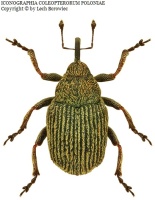
Русские, остановите эту войну! Спасите Свободную Украину!
Russians, stop this war! Save Free Ukraine!
Biodiversity Map
Taxa

Coleoptera Change order
Change order
 Change order
Change order -
Arthropodaphylum
Click to switch
to select orders
and filters > -
Hexapodasubphylum
Click to switch
to select orders
and filters > -
Insectaclass
Click to switch
to select orders
and filters > -
Coleopteraorder
Click to set
as the main taxon
and as a base
← of the left panel > -
Polyphagasuborder
Click to set
as the main taxon
and as a base
← of the left panel > -
Cucujiformiaseries
Click to set
as the main taxon
and as a base
← of the left panel > -
Curculionoideasuperfamily
Click to set
as the main taxon
and as a base
← of the left panel > -
Curculionidaefamily
Click to set
as the main taxon
and as a base
← of the left panel > -
Ceutorhynchinaesubfamily
Click to set
as the main taxon
and as a base
← of the left panel > -
Ceutorhynchinitribe
Click to set
as the main taxon
and as a base
← of the left panel > -
Ceutorhynchusgenus
Click to set
as the main taxon
and as a base
← of the left panel >
species:
Ceutorhynchus sisymbrii
PL
YES
name status: valid name
BioMap ID: 1046013
taxon code: 5565
taxonomy checked: YES
Polish Red List: DD
Data on distribution in Poland

Statistics
- Records: 22
- Publications: 5
- Collections: 2
- Publication authors: 6
- Illustrations (iconography): 1
- Photos (specimen/observation): lacking
Taxon description
Gatunek notowany dotychczas z Niemiec (Brandenburgii, Saksonii i Turyngii), Czech, Moraw, Słowacji, Austrii, Węgier, Rumunii, Ukrainy, Gruzji i Armenii; w Polsce odkryty ostatnio na dwóch stanowiskach koło Hrubieszowa, gdzie był łowiony w maju i czerwcu w większej liczbie osobników, głównie na stuliszu Loesela — Sisymbrium Loeselii L., roślinie żywicielskiej tego ryjkowca. Niewątpliwie należy oczekiwać odkrycia dalszych stanowisk w innych krainach, gdyż wymieniona roślina jest ruderalnym chwastem rosnącym na całym niżu.
Illustrations
... browse
 Ceutorhynchus
Ceutorhynchussisymbrii
External data sources
- Ostatnie rekordy
-
1027563
 ×
× Curculionidae: Ceutorhynchus sisymbrii, PL, Pojezierze Mazurskie, Biebrzański P.N., podlaskie, Biebrzański P.N., Basen Środkowy buffer zone, 1996, leg. M. Wanat (Wanat 2005d)
Curculionidae: Ceutorhynchus sisymbrii, PL, Pojezierze Mazurskie, Biebrzański P.N., podlaskie, Biebrzański P.N., Basen Środkowy buffer zone, 1996, leg. M. Wanat (Wanat 2005d) -
792203
 ○
○ Curculionidae: Ceutorhynchus sisymbrii, PL, Pojezierze Mazurskie, Biebrzański P.N., podlaskie, UTM FE13, 1996, leg. M. Wanat (Wanat 2005d)
Curculionidae: Ceutorhynchus sisymbrii, PL, Pojezierze Mazurskie, Biebrzański P.N., podlaskie, UTM FE13, 1996, leg. M. Wanat (Wanat 2005d) -
791325
 ⊡
⊡ Curculionidae: Ceutorhynchus sisymbrii, PL, Wyżyna Lubelska, lubelskie, Ślipcze ad Hrubieszów, UTM KS82, 1994, leg. J. Szypuła (Szypuła et Wanat 1996(1995))
Curculionidae: Ceutorhynchus sisymbrii, PL, Wyżyna Lubelska, lubelskie, Ślipcze ad Hrubieszów, UTM KS82, 1994, leg. J. Szypuła (Szypuła et Wanat 1996(1995)) -
791323
 ⊡
⊡ Curculionidae: Ceutorhynchus sisymbrii, PL, Wyżyna Lubelska, lubelskie, Gródek ad Hrubieszów, UTM GB03, 1994, leg. J. Szypuła (Szypuła et Wanat 1996(1995))
Curculionidae: Ceutorhynchus sisymbrii, PL, Wyżyna Lubelska, lubelskie, Gródek ad Hrubieszów, UTM GB03, 1994, leg. J. Szypuła (Szypuła et Wanat 1996(1995)) -
741888
 ×
× Curculionidae: Ceutorhynchus sisymbrii, PL (Wanat et Szypuła 1998)
Curculionidae: Ceutorhynchus sisymbrii, PL (Wanat et Szypuła 1998) -
741569
 ×
× Curculionidae: Ceutorhynchus sisymbrii, PL (Szypuła et Wanat 1996(1995))
Curculionidae: Ceutorhynchus sisymbrii, PL (Szypuła et Wanat 1996(1995)) -
602658
 ⊡
⊡ Curculionidae: Ceutorhynchus sisymbrii, PL, Wyżyna Lubelska, lubelskie, Gródek ad Hrubieszów, UTM GB03, 1994, leg. M. Wanat (Szypuła et Wanat 1996(1995))
Curculionidae: Ceutorhynchus sisymbrii, PL, Wyżyna Lubelska, lubelskie, Gródek ad Hrubieszów, UTM GB03, 1994, leg. M. Wanat (Szypuła et Wanat 1996(1995)) -
599010
 ×
× Curculionidae: Ceutorhynchus sisymbrii, PL, Pojezierze Mazurskie, Basen Środkowy, Biebrzański P.N., podlaskie, Osowiec Twierdza, UTM FE02, 1997, leg. M. Wanat (Wanat et Szypuła 1998)
Curculionidae: Ceutorhynchus sisymbrii, PL, Pojezierze Mazurskie, Basen Środkowy, Biebrzański P.N., podlaskie, Osowiec Twierdza, UTM FE02, 1997, leg. M. Wanat (Wanat et Szypuła 1998) -
597413
 ×
× Curculionidae: Ceutorhynchus sisymbrii, PL, Pojezierze Mazurskie, Basen Środkowy, Biebrzański P.N., podlaskie, Osowiec Twierdza, UTM FE02, 1998, leg. M. Wanat
Curculionidae: Ceutorhynchus sisymbrii, PL, Pojezierze Mazurskie, Basen Środkowy, Biebrzański P.N., podlaskie, Osowiec Twierdza, UTM FE02, 1998, leg. M. Wanat -
596792
 ×
× Curculionidae: Ceutorhynchus sisymbrii, PL, Podlasie, Basen Południowy, Biebrzański P.N., podlaskie, Osowiec Twierdza, UTM FE02, 1998, leg. M. Wanat
Curculionidae: Ceutorhynchus sisymbrii, PL, Podlasie, Basen Południowy, Biebrzański P.N., podlaskie, Osowiec Twierdza, UTM FE02, 1998, leg. M. Wanat - ... more
- Powiązane publikacje
-
Wanat M. 2005d. Ryjkowce (Coleoptera: Curculionoidea bez Scolytinae) Biebrzańskiego Parku Narodowego i jego otuliny. [In:] Dyrcz A., Werpachowski C. (Eds.) Przyroda Biebrzańskiego Parku Narodowego. Osowiec Twierdza. pp. 301-324.
 Show records
Show records -
Wanat M., Gosik R. 2003a. Materiały do znajomości ryjkowców (Insecta: Coleoptera: Curculionoidea) doliny Bugu. Nowy Pam. Fizjogr., 2(1-2):31-52.
 Show records
Show records -
Wanat M., Szypuła J. 1998. Interesujące gatunki ryjkowców (Coleoptera: Urodontidae, Curculionidae) ze wschodniej Polski. Wiad. Entomol., 17(2):85-94.
 full text
full text Show records
Show records -
Burakowski B., Mroczkowski M., Stefańska J. 1997. Chrząszcze – Coleoptera. Ryjkowce – Curculionidae, część 3. Katalog Fauny Polski, XXIII, 21, Warszawa.
 Show records
Show records -
Szypuła J., Wanat M. 1996(1995). Nowe dane o rozmieszczeniu niektórych gatunków ryjkowców (Coleoptera, Curculionidae) w Polsce. Wiad. Entomol., 14(4):219-226.
 full text
full text Show records
Show records
- Powiązane zbiory
-
Szypuła J.
 Show records
Show records -
Wanat M.
 Show records
Show records
- Wykaz powiązanych pozycji
-
Curculionoidea of Poland
 Show records
Show records




